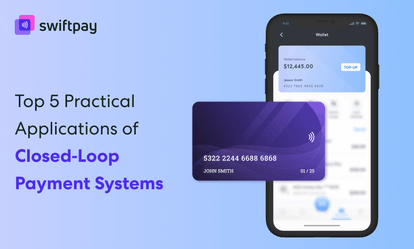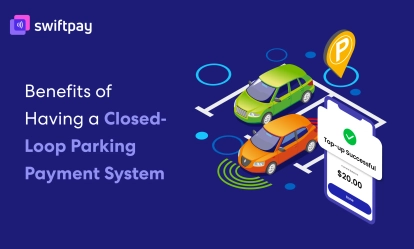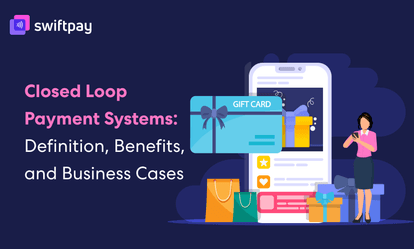Kevin Stirtz, the author of More Loyal Customers and Marketing for Smart People, once said:
“Every contact we have with a customer influences whether or not they’ll come back. We have to be great every time or we’ll lose them.”
That is such a profound statement; it highlights the critical role of customer experience in business success. Each touchpoint—especially financial transactions—is an opportunity to either strengthen or erode customer loyalty.
Closed-loop payment systems align perfectly with this principle. By taking full control of your payment ecosystem, you can deliver a smoother and more personalized experience at every transaction.
Whether you’re speeding up checkouts, securing sensitive data, or building loyalty programs, the right closed-loop wallet solution doesn’t just facilitate payments—it turns them into meaningful moments that strengthen your connection with customers. But how can you do it?
In this blog we will break down:
- What exactly are closed loop wallets
- Key features of closed-loop wallets
- Things to consider before choosing a closed-loop wallet
- Cost analysis of closed-loop wallet
- How to get started with closed-loop wallet system
So, without any further ado, let’s get started.
What are closed-loop wallets?
Closed-loop wallet systems operate on an exclusive digital payment ecosystem. These systems store customer funds in a digital account tied to your business so that all transactions occur within your network. The key components of these systems are:
-
Wallet interface: A user-friendly app or web platform where your customers access and manage funds.
-
Integration with merchant’s existing systems: Links to already existing systems like point-of-sale (POS) and backend systems for seamless processing.
-
Transaction records: Helps you keep track of fund balances and transactions accurately and in real-time.
Difference between closed-loop payment systems and traditional payment systems
Unlike open-loop systems (credit/debit cards), closed-loop payment systems only operate within the network of a specific merchant (let’s say your business). This ensures lower processing fees, greater control, and the ability to offer unique incentives like discounts and rewards.
Technical infrastructure and integration capabilities
To work effectively, closed-loop wallets require robust technical infrastructure:
-
Payment gateways: Allows you to process payments securely and efficiently.
-
APIs: Helps you facilitate integration with POS, CRM, and analytics tools.
-
Security layers: Lets you protect sensitive data with encryption and multi-factor authentication.
Operational mechanics of closed-loop wallets
Digital value storage mechanisms
Funds in closed-loop wallets are stored as a digital value (it could be real money or also virtual currency as points or rewards). Customers can load money via bank transfers, cards, or in-store top-ups, which makes transactions quick and cashless.
Transaction processing protocols
Transactions are processed instantly within the merchant’s ecosystem. The system verifies available funds, approves payments, and updates balances in real-time.
Security and authentication frameworks
To ensure the security of transactions, closed-loop payments leverage:
-
Encryption protocols: To secure sensitive data during transactions.
-
Fraud detection: To monitor unusual activity to prevent unauthorized access.
-
Multi-factor authentication (MFA): Adds an extra layer of security for users.
Key features to look for in a closed-loop wallet solution

There are several features that are essential for proper functionality for closed-loop wallets. Let’s explore some of them:
Seamless integration
Your chosen solution must integrate effortlessly with your existing systems. Prioritize closed-loop wallets compatible with your POS and CRM platforms to:
- Eliminate manual data entry
- Synchronize data across different systems
- Ensure real-time transaction updates across all business systems
Robust security
Security isn't optional—it's a must. Look for solutions that offer:
- End-to-end encryption
- Advanced tokenization techniques
- Real-time fraud detection mechanisms
These features protect sensitive payment data, ensure regulatory compliance, and help you build customer trust.
Customization capabilities
A powerful closed-loop wallet adapts to your unique business needs. Hence, you should seek solutions that provide:
- Flexible branding options
- Configurable interface designs
- Functionality tailored to your specific industry requirements
Omnichannel accessibility
Modern customers demand versatility. Your closed-loop wallet should support transactions across:
- In-store point-of-sale
- Online purchasing platforms
- Mobile payment systems
User-friendly experience
Intuitive design drives adoption. Ensure your solution provides:
- Simple fund management
- Transparent transaction histories
- Streamlined navigation for customers and employees
This list is non-exhaustive, but by focusing on these features you are most likely to see enhanced operational efficiency and deliver exceptional customer experiences.
Things to consider before choosing a closed-loop wallet system
There are some crucial things that you need to consider in multiple aspects before settling for a closed-loop wallet system for your business. Let’s see some of the key things:
Technical evaluation parameters
When evaluating a closed-loop wallet solution for your business, focus on these critical technical aspects:
-
Scalability: You have to make sure that the solution can handle increased transaction volumes as your business grows. Besides, you need to ensure that the infrastructure can support future expansions without performance bottlenecks.
-
Integration capabilities: You should verify the wallet integrates effortlessly with your existing systems, including POS, inventory management, and analytics tools; just so you can minimize your operational disruptions.
-
Security: You must evaluate encryption protocols, data tokenization methods, and compliance with regulatory standards to ensure robust protection for sensitive data.
-
Customization potential: The solution should adapt to your specific operational needs and branding requirements so that you can tailor features accordingly for maximum impact.
Performance metrics
Key performance indicators (KPIs) can help you measure your closed-loop wallet solution's effectiveness. Look for wallets that excel in:
-
Transaction speed: Quick and seamless processing to reduce wait times during checkouts.
-
Reliability: Systems that minimize downtime or glitches to help you maintain a consistent customer experience.
-
User experience design: Intuitive layouts that simplify processes for both staff and customers.
-
Reporting and analytics: System that provides detailed insights into transaction patterns, customer preferences, and operational performance to drive informed decision-making.
Compliance and regulatory alignment
Adhering to legal and regulatory frameworks is critical because that’s how you avoid penalties and maintain trust. Hence, you should ensure that your closed-loop wallet solution complies with payment security standards like PCI DSS, GDPR (if applicable), and local regulations governing financial transactions. Complying with such standards means your business remains legally protected while providing a secure experience for customers.
Total cost of ownership analysis
Let’s break down what costs could be involved in a closed-loop wallet solution:
Initial implementation expenses
The initial expenses of a closed-loop wallet solution comprise:
- Hardware
- Software licensing charges
- Integration with current systems
Assess these costs to see if they align with your budget and the value proposition of the solution.
Ongoing maintenance considerations
Post-implementation costs can include:
- System upgrades
- Staff training
- Customer support
Therefore, regular maintenance ensures the system remains efficient and secure, however, it’s crucial to factor in these recurring expenses when evaluating total cost.
ROI calculation methodologies
Return on investment serves as a crucial measure when selecting a wallet solution. Think about how reductions in transaction costs, enhanced customer loyalty, and higher sales from tailored promotions impact your ROI. Assess the speed at which the wallet will become self-financing and its financial advantages over time.
Long-term strategic value assessment
In addition to short-term gains, consider how the wallet contributes to the long-term success of your business. Does it establish your brand as forward-thinking? Is it capable of adjusting to changing customer demands and market dynamics? A strategic approach must promote ongoing growth and provide a competitive edge.
How to get started with a closed-loop wallet solution
Here are a few points you need to consider to get started with a closed-loop wallet solution for your business:
Assess your business needs and objectives: Start by recognizing the challenges and objectives of your business. Do you want to lower transaction costs, enhance customer loyalty, or simplify checkout procedures? Understanding your priorities will assist you in choosing the appropriate features.
Compare providers and request demos: Research multiple providers, focusing on their features, ease of integration, and pricing. Request live demos to assess usability and understand how the solution works in real-world scenarios.
Plan a phased rollout: Instead of launching the wallet system across all locations at once, start with a pilot program. This allows you to identify and address potential issues before full implementation.
Monitor and refine based on customer feedback: Gather input from customers and staff throughout the trial stage. Utilize these findings to enhance the wallet's functionalities and guarantee a seamless experience for every user.
Conclusion
Every transaction tells a story. When you choose the right closed-loop wallet solution, you’re writing a narrative of convenience, security, and customer-first innovation.
Hence, when you choose a closed-loop wallet for your business, it’s not just about ticking off features; it’s also about:
- Building a system that supports your business goals
- Providing better experience to customers
- Taking your business to the next level
Every detail matters–from integration capabilities to customer experience features. You have seen in this blog how thoroughly evaluating your options and matching them with your business needs, you can deliver a payment experience that’s efficient, secure, and tailored to your customers.
Whether you’re starting your search or ready to take the leap, our closed-loop payments experts at SwiftPay can help you assess your closed-loop payment needs, understand them and deliver a customized solution.
Now is the time to invest in a solution that does more than process payments. It empowers growth, trust, and loyalty.
With the right partner, you’re set to deliver a payment experience that stands out.




